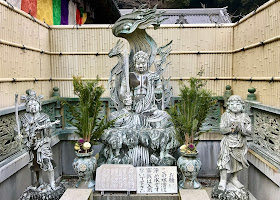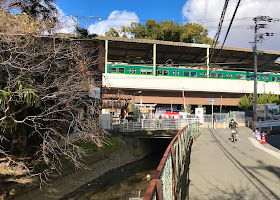Tenbun closed on March 28, 2020. The space it occupied was empty for a year and a half. Then on October 10, 2021, a new shop opened, Peke x Peke. I walked by the new shop a few times but never felt right about going in. But a couple weeks ago I went there to take photos and I did go in for a drink. Of course, it just wasn't the same. It seemed (bias warning) too new, artificial, cheap, trying too hard to be hip and stripped of any tradition and personality. I couldn't believe they tore out the beautiful old counter and replaced it with what they did. There weren't many customers (but it was a Monday evening) and none of the old Tenbun regulars were there. Replacing old shops with new chain stores is a part of the gentrification process going on at Keihan line train stations. Peke x Peke is not a chain. The manager told me that this is the only location with this particular configuration. But the owner has multiple shops.
You can get a good idea of the new configuration in my photos and then with photos from a web site I include below. Scroll to the end of this post for a link to see our beloved Tenbun.
Photos that accompnaied the announcement of the new shop on "Ko-shin," the Hirakata-shi Featured Event (i.e. advertisements) website.
https://www.hira2.jp/open-close/batubatu-20211018.html
Congratulatory flowers in front of the shop when it opened.
The new layout, counter, big screen TV...
Seating...
Take-out window.
Here's where to go to see Tenbun:
https://visualanthropologyofjapan.blogspot.com/2020/12/behind-scenestenbun-closingpresentation.html
Explorations and experiments in visual representations - multimodality, sensory ethnography, reflexivity, autoethnographic vignettes, ethnographic photography and ba...
Saturday, January 28, 2023
Friday, January 6, 2023
Pilgrimage to Hozanji 1/5/2023
One of my favorite places in Japan... for the journey on the the winding mountain paths, for the natural setting, for the unlimited photo ops, for the spirituality, for the tako yaki and amazake, for the visual anthropology of Japan. For the first time since 2019 I was able to make my New Year's pilgrimage to Hozanji in Nara prefecture...
Set I
Set II
Set III
Set IV
Set V
See the photos from 2019 and links to previous Hozanji pilgimage posts:
https://visualanthropologyofjapan.blogspot.com/2019/01/2019-new-years-pilgrimage-to-hozanji.html
Set I
Set II
Set III
Set IV
Set V
See the photos from 2019 and links to previous Hozanji pilgimage posts:
https://visualanthropologyofjapan.blogspot.com/2019/01/2019-new-years-pilgrimage-to-hozanji.html
Wednesday, January 4, 2023
Jalan Jalan (101): A milestone in the VAoJ series that took a too long a time in coming (due to accidents, injuries, COVID-19, busy work schedule, etc.)
UPDATE: It seems I reached the milestone on July 8, 2022 and forgot about it... Oops!
What is jalan jalan?
Walking with my camera(s) is one of my most favorite activities. It's a form of joyous and holistic meditation - good for the mind (walking out the stress; letting one's mind wander) and body (good exercise; but don't forget the sunscreen...). During my fieldwork in Bali I found I needed time to myself so I started to take an early evening walk. My Balinese friends called it jalan jalan and jokingly translated it [through their kata kolok sign language from Indonesian language] as "walking for nothing." When walking for nothing one sees things that might be otherwise ignored. It is fun to record such observations with photography. See (some of) the things I notice and record on my morning walks in my Kansai neighborhood. Sometimes there might be themes to the photos and sometimes there might be more abstract (weird) photos similar to previously posted ones that have been referred to as untitled, くわしく (details), random and/or accidental. If nothing else it's an excuse to explore my neighborhood again and play with my new cameras...
Source: Jalan Jalan (1): Introducing the Summer Walk Series
https://visualanthropologyofjapan.blogspot.com/2018/06/jalan-jalan-1-introducing-summer-walk.html
Tuesday, January 3, 2023
First visit to Kayashima Shrine for the New Year 2023
Kayashima Shrine is famous because there is a train station right above it. The kami-deity associated with the shrine resides in a large 700 year old Camphor tree. When the train station was being built, the tree could not simply be cut down. Thus the station was built around it. The tree/kami is seen as especially powerful. Many people claim their wishes have come true after praying and giving a small cash offering. The shrine is small but contains a lot of interesting sights.
See also「Ringing in Reiwa 2 @ Kayashima Jinja」
https://visualanthropologyofjapan.blogspot.com/2020/01/ringing-in-reiwa-2-kayashima-jinja.html
See also「Ringing in Reiwa 2 @ Kayashima Jinja」
https://visualanthropologyofjapan.blogspot.com/2020/01/ringing-in-reiwa-2-kayashima-jinja.html
Monday, January 2, 2023
An update on the New Year's greeting...
Updating Happy New Year 2023 from「VAoJ」
It seems some houses and businesses were just a little late with their decorations. But still, there are far fewer this year than in previous years. I especially like the wordplay for this poster at a neighborhood mom and pop barber shop.
It seems some houses and businesses were just a little late with their decorations. But still, there are far fewer this year than in previous years. I especially like the wordplay for this poster at a neighborhood mom and pop barber shop.
Sunday, January 1, 2023
Happy New Year 2023 from「VAoJ」
This is only anecdotal, but I have noticed in and around my neighborhood that houses are not displaying New Years decorations like the shimekazari in the photo above like they have done in the past. Even many businesses aren't displaying decorations or posters. Traditions change... But anyway, Happy New Year! Here's hoping and praying that 2023 is better than the last. Not so much to ask, is it?























































